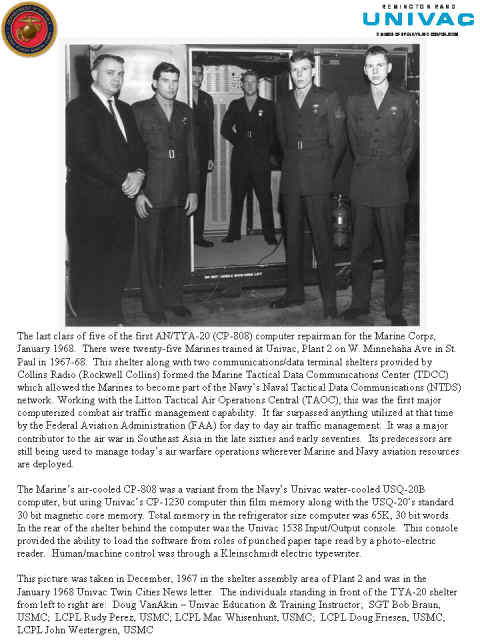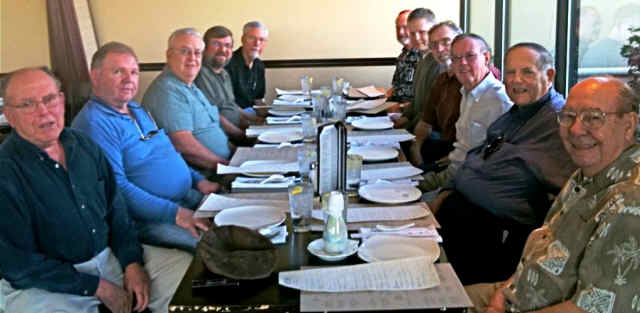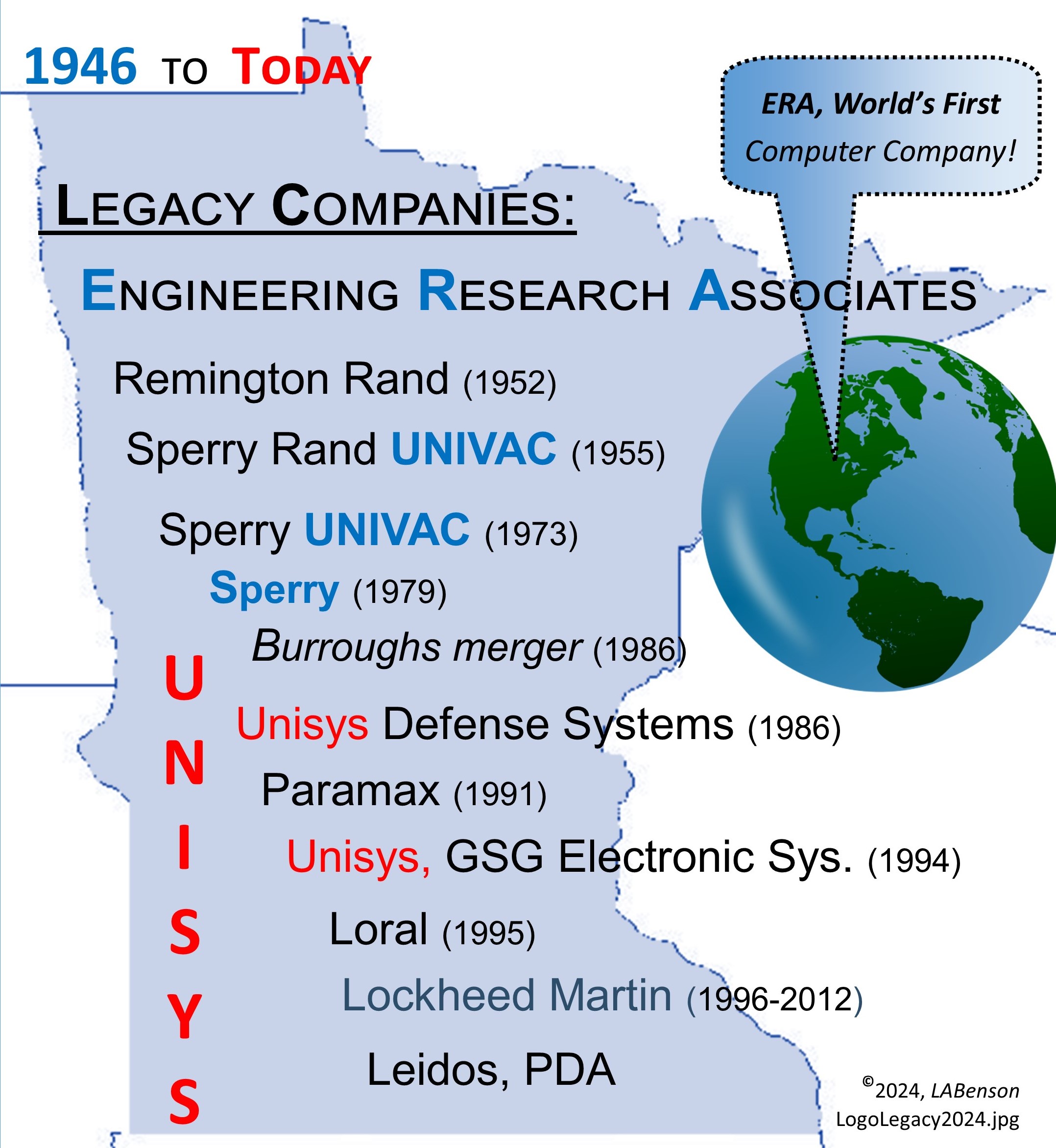

Information Technology (IT) Pioneers
Retirees and former employees of Unisys, Lockheed Martin, and their heritage companies
Marines' Systems, Chapter 65
1. Introduction
Several Personalities [characters] were in Univac Marine Corps
(USMC) Systems
in the mid 1970's. Program Manager was Dan Massoratti, Marketing Managers
were John Markfelder and Hugh Windland. The Logistics Engineer
was Earl Lillistrand, the Engineering Manager was Wayne Leverkuhn, and
others included: John Westergren, Clint Jurgens, Tom Kratz, and Ole.
Before Dan, we had a few thousand dollars in spare parts annually. After
Dan, in the 1960's we were up to $6M per year.
These people were support for the Marine Tactical Data Systems (MTDS) as described in the 'John Westergren' contributed article below.
2. USMC NALCOMIS (Logistics) Demonstration and 1974 TPQ-27 Pentagon Marketing Visit
John Markfelder had us working on a TPQ-27 program that he was trying to wrest away from RCA (the follow on). RCA had finished an initial contract for $13M and had not even delivered the source code. John had Ole assemble a Tiger Team to analyze the TPQ-27 situation. This one month study included a powerful team: "Rip Anderson, Tom McSherry, Chuck Lutes, Gus Tallman, and Ole". Ole was at Dan Massoratti's Cottage Grove home preparing the final TPQ-27 report full of "zingers". John's plan was to drop the report into in baskets in the Pentagon.
The phone rings, it's Markfelder calling from Washington. "The two boxes of computer equipment arrived OK, but the box containing all the cables is missing. Ole: "John, you should not have signed up if you can not take a joke" (He never did say that to Ole again). You could hear John's response all over the house. After Dan got John settled down, Ole talked to John: "Have you called Floyd Pnewski and Jerry Green?" Who do you suppose that I called just before I called you? They are at Plant 8 doing whatever is necessary to assemble cable pieces for you to bring to Washington DC this afternoon. I went to Plant 8, and ran right into Floyd. Floyd said: "I knew that it was bad luck when I saw you yesterday". I had told Floyd: "How can a major Demo take place without your involvement?" You know how it is, time moves on, you get helpers who take care of things for you. Three packing boxes full of cable PARTS were assembled for Ole to take to the airport.
Unfortunately, at this point in Ole's career he did not have a
company charge card, a full bank account, nor a personal credit card
that would cover the cost of transporting these three boxes to DC on
that plane. Ole shows up early at the departure gate, and in the
course of the conversation with the young lady says: "I will bet
that you are Norwegian". I am. How did you know? "Norwegians are so
friendly and helpful. If I don't get these three boxes to DC today I
will lose my job. "Take one into the aircraft, go right to back and
try to put it under the seat, even though it will not fit. The
Flight attendants will be there". I followed her advice. When the
box would not fit under the seat, the flight attendants said: "We
are not going to be full today, just strap it into the seat". Coming
in with the second box I said: "There is only one more". When I came
in with the third box I said: "There is only one more and here it
is". I had 4 seats that day for the price of one. The crew that made it work that day in DC
were John Westergren and Doug Hair. The Demo was a great success.
The night before going to the Pentagon, Rip and Ole were looking
out the third story hotel window, when Markfelder and Windland
were coming in. Rip said: "Put these beer cans on the ledge, and we
will push them off when their feet hit the curb." It sounded just like
guns firing. They looked up and Markfelder came right up. Rip
said watch this: Tom McSherry's paper written by an expert geometrician,
was several pages long. Ole has a college degree in Mathematics, and
he could understand only the first two paragraphs. Rip to John: "This
paper is critical to our marketing effort tomorrow, and it should be
explained by Marketing". John just threw it back, saying that he would
never understand it. 1/2 Hour later John said: "We have a rookie marketer"
and called Windland to come down. Rip gave his intro. Windland was on
page 8 before he realized that it was a joke.
RIP Anderson and Ole went with John Markfelder and Parker
Follsom to the Pentagon to talk about TPQ-27. We knew that this was
important when that grand old gentlemen, Parker Follsom, got lost leading
the way. After the meetings, John said to Ole and Rip that you both
talked slow enough today that I could almost understand you.
![]()
3. Marine Tactical Data Systems (MTDS) by John Westergren
MTDS development integrated the Naval Tactical Data System with the
shore based Marine operations. See image immediately below, Lance
Corporal John Westergren is the rightmost Marine in 1967! We thank him for this paper donation.

4. Marine Air Traffic Control And Landing System
We also developed for the Marine Corps the Marine Air Traffic Control and Landing System (MATCALS) as a tactical air traffic control system that could provide arrival and departure control of aircraft within a 60-nautical-mile radius of the airfield. The system is portable and can be moved and erected at an existing airfield, or used with an expeditionary setup. The relationship of MATCALS to our Air Traffic Control business is another example of applying technologies and equipment to multiple problems of a similar nature. [lab]
Univac started MATCALS with UYK-7 computers much earlier than with UYK-20s mentioned in the history with a processing facility in Sunnyvale funded through NAVELEX Vallejo using rewritten FAA ARTS using CMS-2 software — Bill Exely (spelling?) ran the Sunnyvale facility. {Editor's note: The Compiler Monitor System-2 was created to recompile the Navy's CP-642B 30-bit software to 32-bits for the UYK-7. The FAA's Input/Output Processor (IOP) had the same basic 30-bit repetoire as the 642B.} Other MATCALS players at the time were Bell Aerospace for the SPN-42 software, ITT Gilfillan for a color display, System Development Corporation for Requirements and Specifications, Auburn University and MIT for theory. The test bed at Patuxent River was being built at the same time. That was a long time ago but I may be able to find other information if that is of interest to your history. John Mulhern
 Sperry*Univac/Paramax/Unisys/Lockheed-Martin operated the MATCALS
Support Facility on Mare Island from 1977 until the shipyard shut down
in 1995. MATCALS, of course, is the acronym for Marine Air
Traffic Control And Landing System.
This was the facility responsible for the software development, integration
and testing of MATCALS. Many people in the Twin Cities also worked on
portions of this program especially the Multi-Mode Display (MMD) and
the Control and Communications Subsystem (CCS).
Sperry*Univac/Paramax/Unisys/Lockheed-Martin operated the MATCALS
Support Facility on Mare Island from 1977 until the shipyard shut down
in 1995. MATCALS, of course, is the acronym for Marine Air
Traffic Control And Landing System.
This was the facility responsible for the software development, integration
and testing of MATCALS. Many people in the Twin Cities also worked on
portions of this program especially the Multi-Mode Display (MMD) and
the Control and Communications Subsystem (CCS).
On 8 October 2010, those of still in the area met for lunch. Pictured in
the photo from left to right are: Scott Hovey, Doug Mogler, Harold Brondum,
Mark Schroeder, Dennis Larson, Vern Sandusky, Jeff Pauling, Foster Poole,
Ron Irwin, Gordy Erickson and Ted Lingenfelter. Some of those pictured
were on the project from its inception in 1977 until the shipyard closed.
Ron Irwin continued to support the program long after it moved to San
Diego. With the exception of Mark & Jeff, all are retired.
MATCALS featured several significant "firsts" for Univac including Finger
on Glass (FOG) overlaying a full-color raster scan display, embedded
UYK-44, Serial Data Bus [very similar to the CPF SHINPADS bus], distributed &
fault tolerant operating system and more that I just cannot remember.
Submitted by Vern Sandusky
Stories are:
MATCALS descriptive document
scanned by Ron Irwin with formatting by Lowell. MATCALS -
Controlling the Skies written in 1993, author unknown and "Deployment
to Somalia" by CWQ4 John P. Rego, March 1996. Both articles
submitted by Ron Irwin.![]()
MATCALS HISTORY – By Ron Irwin, Last Updated 11/23/2010
- 1978 – 1980 - Basic Operational Capability (BOC) program developed and demonstrated. This was basically a feasibility demonstration program. AN/UYK-20's with Motorola Totalscope displays. Staffing: 1978 = 10, 1979 = 18, 1980 = 20
- 1981 - 1985 - Development of Full Operational Capability (FOC). Current MMD configuration. Performance testing end of 1985. Staffing: 1981 = 30, 1982 = 50, 1983 = 60, 1984 = 70, 1985 = 70. Figures in 1982 - 1985 include approximately 10-15 Eagan programmers/documentation/test personnel.
- 1986 - Operational testing and IOC completed. Staffing: 60 (on and offsite).
- 1987 - Version F fielded. Continued implementing new capabilities via SCPs. Staffing = 57.
- 1988 - 1989 - Development of AN/TPS-73 radar version - Version G. Staffing: 1988 = 53, 1989 = 48
- 1990 - Added TADIL-B to Versions H and J (AN/TSQ-107 ASR). Passed TB certification testing. Staffing = 43.
- 1991 - Added TB to Version K (AN/TPS-73 ASR version). Staffing = 48.
- 1992 - 1993 - Version L developed and delivered with 14 SCPs. Staffing: 1992 = 40, 1993 = 28.
- 1994 - 9/95 - Started Version M development with 13 SCPs. Staffing: 1994 = 19, 1995 = 16. Close of Mare Island and relocated to NRaD, San Diego 9/95.
- 1996 - Transition of software to new Sun development system at NRaD/SSCSD. Staffing: 7
- 1997 - 1998 - Began work on completion of Version M. Added MAF maintenance task to contract. Staffing: 1997 = 9, 1998 = 8
- 1999 – 2000 - Continued work on Version M. SSCSD took over complete SSA. Pax River no longer involved. Version M passed all testing by March 2000 and delivered to the field late 2000. Staffing: 1999 = 5 LM (4 programmers, 1 field engineer), 2 SSCSD; 2000 = 4 LM (3 programmers, 1 field engineer), 2 SSCSD.
- 2001 – 2003 - Continued SSA with 2 LM programmers, one LM field engineer, and 1 SSCSD manager.
- 2004 – No software work performed. SSCSD continued providing tapes to the field. Staffing: No LM software support, one LM field engineer and 1 SSCSD SSA manager.
- 2005 – 2006 Renewed SSA work on Versions M1, M2, and M3. M1 had one SEP implemented, but was not complete. M2 completed the SEP implementation, passed all tests, but never received approval to deliver to the field. M3 implemented one SCP for a TADIL-B change to the standards. M3 completed all testing and was fielded in 2007. Staffing: 2 LM programmers [new to MATCALS], 1 LM field engineer, and 1 SSCSD SSA manager. Additional consulting support from a LM retiree (Ron Irwin).
- 2007 – March 2010 Continued SSA with 2 LM programmers, one LM field engineer, and 1 SSCSD manager. No additional deliveries made to the field.
- March 2010 - All SSA work ended. No further LM support. One
SSCSD manager continues to provide minimal support for tapes, questions,
etc.

5. TERPES by Cal Webster - system user & maintainer
I worked on these computers from about August of 1984 until they were phased out many years later as part of what was then known as the "Tactical Electronic Reconnaissance Processing and Evaluation System" or "TERPES". As I recall, we were the only USMC unit using them. My primary instructor at MCB 29-Palms, CA told us we'd never see one.
When I arrived they were disassembling the old punch card machines
and readers and replacing them with paper-tape punch/readers. I'll have
to dig back in my old stuff to get more detailed info. They seemed to
break-down a lot but were very simple to isolate malfunctions and replace
the single-card flip-flops or addressing logic.
These second cousins to the ENIAC were essential to the real-world peacetime
reconnaissance missions in which the Marine Corps participated during
the "Cold War". During deployment aboard one of our carriers the TERPES
electronic/signals intelligence analysts were instrumental in pinpointing
at least one "missing" non-ally submarine that surfaced briefly during
a routine recon mission. Because the sub only emitted a short burst
of radar pulses, the contact was undetectable to the Electronic Counter-Measure
Officers who rely mainly on audible tones and alarm lists. Only after
carefully analyzing the reconnaissance data brought back by the aircraft
was the detection made and verified. During operations Desert Shield
and Desert Storm, VMAQ-2 (and TERPES) were singled out by the SecNav
for the vital role they played in detecting radar emitters and clearing
paths for coalition forces to more safely ingress and egress to and
from their targets.
P.S. I still have a faulty core memory NDRO module that I saved as memorabilia
of those times.
On Thu, 2009-11-19 at 07:15 -0700, Westergren, John H wrote:
Great hearing from another CP-808 technician. I was one of the first
25 trained in the factory school in 1967 here in St. Paul, MN (where
I now work for Lockheed Martin). After completing that and ending up
as a MOS-5977, I spent all of my time in MACS Squadrons (3,4,7,8) on
the west coast and Okinawa. Great duty for six years until I decided
I’d had enough. I’ve been primarily here in MN working for
Univac, Unisys, & Lockheed Martin [really all the same company after
mergers and acquisitions] since I got out in ’72.
I was aware of TERPES in the ‘80’s, but was working on a number of different programs at that time, so I didn’t get any details. Interesting how a good 1960’s technology could still pull its own weight after 25-30 years in service. We’d be happy to hear about any other information, background or stories concerning TERPES and the CP-808 for our website.
Stay in touch. By the way one of my other activities is being a Marine For Life Mentor for Marines recently leaving the Corps. I still get a kick out of talking with some pretty special individuals.
Semper Fi,
Hi John!
It's a privilege to make your acquaintance. I was intrigued by some
of the stories and history I dug up when I began "googling" for CP-808.
A friend of mine had sent me an article about the new
stackable phase-change memory being developed. He had remarked about
how it reminded him of core memory. In my reply I made some references
to the CP-808 so I looked around to check my facts and find a photo
or two.
I was a 6112/6179 CH-46 Crew Chief/Mechanic, Natops Evaluator, Line
Chief for my first 11 years. I made a lateral move to become a 5977.
After MOS restructuring it was changed to 2821 until I was promoted
to MSgt when I became a 2891.
Please feel free to publish on your web site what I wrote in
my original email if you want. I'll see what else I can dredge up from
my Swiss-cheese memory banks and dust off some of those old boxes in
my closet and attic. We [TERPES] had a continued presence in Iwakuni
Japan, staffed by rotating detachments out of "Q2". The base newspaper
[Torii Teller] did a story on us once. I'll see if I can find the copy
I saved too. It might even have some photos of the computers. "Semper
Fi" right back at ya! Cal
![]()
In this Chapter
- Introduction [left]
- Logistics Demonstration and TPQ-27 Marketing
- Marine Tactical Data Systems
- Marine Air Traffic Control and Landing System (MATCALS)
- TERPES (Tactical Electronic Reconnaissance Processing and Evaluation System)
Chapter 65 edited 7/13/2025.
